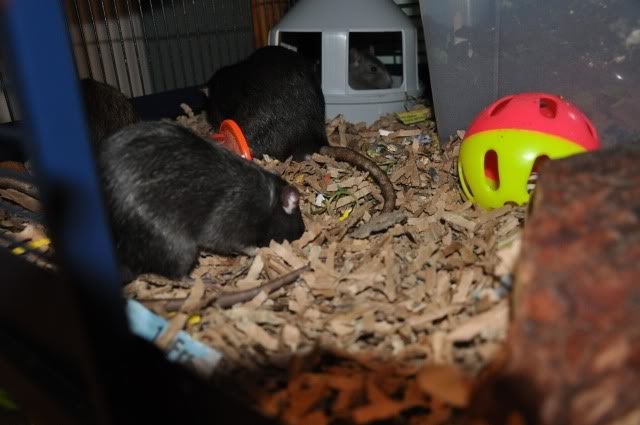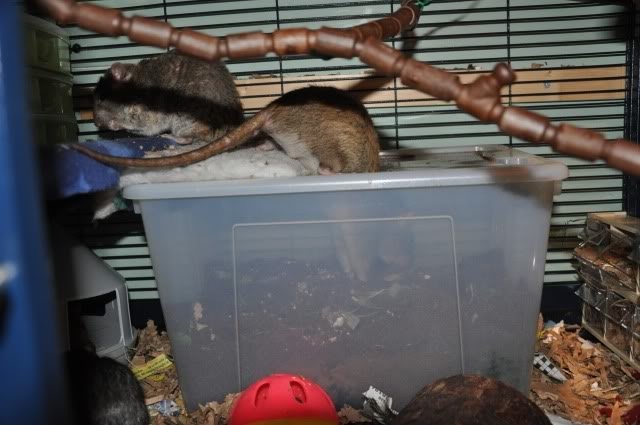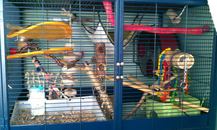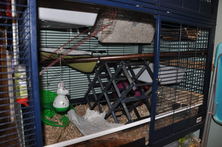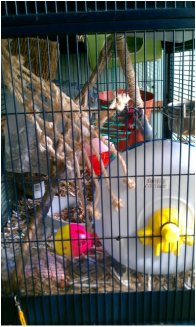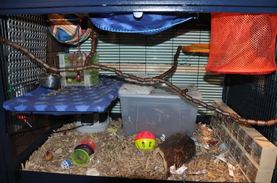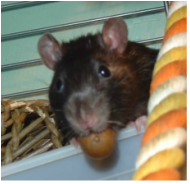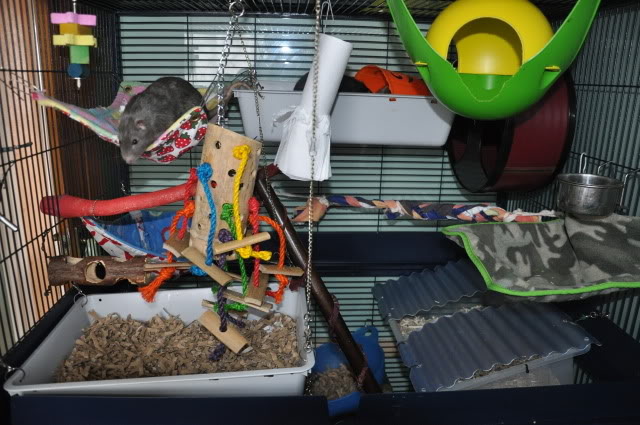Cage Enrichment - focusing on natural behaviours
One of the key things in setting up any environment for your animal is to focus on what behaviours they naturally exhibit and giving them chances to use these. It is easy to fall into the trap of setting up the cage from a human perception, this can be focusing on everything being comfy looking, snuggly and easy to get around (as your little guy might struggle to get from A to B without a ramp to climb up), or even decorating the cage to look pretty with many matching hammocks and fleece floor coverings. This isn’t to say a good setup can’t look good too, but that your first thoughts should go to meeting your rats natural behaviours, and then you can think about colour coordination if you really want to (I opt for the clashing approach, cram enough bright colours into a cage and it looks like you’ve meant it to be that way!).
So from this we can look at what behaviours you want to encourage. I find that when you’re first setting up a new cage or embarking on this journey it can be useful to mentally tick off against each behaviour. Once you’ve done things a few times you’ll almost be pretty instinctively adding in some vertical climbing, running, foraging etc. I should add, this shouldn’t need to cost the world. My cage set ups don’t tend to cost lots and have been gathered over the years mainly focused on things that aren’t originally made for rats and often are repurposed with minimal time and effort and some fairly basic tools. The rat will often love that foraged branch or adapted plant pot just as much as a fancy sputnik or expensive rat rope.
So from this we can look at what behaviours you want to encourage. I find that when you’re first setting up a new cage or embarking on this journey it can be useful to mentally tick off against each behaviour. Once you’ve done things a few times you’ll almost be pretty instinctively adding in some vertical climbing, running, foraging etc. I should add, this shouldn’t need to cost the world. My cage set ups don’t tend to cost lots and have been gathered over the years mainly focused on things that aren’t originally made for rats and often are repurposed with minimal time and effort and some fairly basic tools. The rat will often love that foraged branch or adapted plant pot just as much as a fancy sputnik or expensive rat rope.
Running
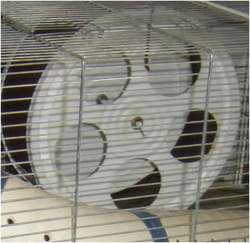
A Wodent Wheel
In the wild rats can run significant distances, they tend to bunny hope along when given change to really extend themselves. Running helps both with physical fitness and stamina. Whilst a cage can be a little limiting for full blown running (free range will help with this) having a good amount of floor space which isn’t overly cluttered with floor toys and igloos can help a lot.
The other major option to encourage running in a cage is a wheel, this needs to be big enough for the rats to run with a straight back, which usually means a wheel of 12-13 inches minimum diameter. There are a few good wheel brands in the ok, and the style of wheel can depend on your rats preferences. In general I find the fast lightweight silent spinner suits girls and babies more (its lack of central axis helping them really get up speed) and the slower but slightly larger Wobust wodent wheel tends to suit bucks, who often prefer to trot rather than outright run. You should avoid wheels with wire barred running surfaces as they can cause accidents. Rats are also more likely to wheel run if they have had them available from a young age. I’ve also found that often when you think your rats aren’t using a wheel they use it when you’re not around. I once came down in the middle of the night to check on something only to find the boys queuing up to use their wodent wheel which I was sure hadn’t been used for months
The other major option to encourage running in a cage is a wheel, this needs to be big enough for the rats to run with a straight back, which usually means a wheel of 12-13 inches minimum diameter. There are a few good wheel brands in the ok, and the style of wheel can depend on your rats preferences. In general I find the fast lightweight silent spinner suits girls and babies more (its lack of central axis helping them really get up speed) and the slower but slightly larger Wobust wodent wheel tends to suit bucks, who often prefer to trot rather than outright run. You should avoid wheels with wire barred running surfaces as they can cause accidents. Rats are also more likely to wheel run if they have had them available from a young age. I’ve also found that often when you think your rats aren’t using a wheel they use it when you’re not around. I once came down in the middle of the night to check on something only to find the boys queuing up to use their wodent wheel which I was sure hadn’t been used for months
Foraging
Rats in the wild they would naturally forage for their food, this typically can range from searching for seeds and berries in undergrowth to rooting through rubbish for their next meal. Putting it simply they have evolved to work for their dinner. Offering food in a simple bowl does ensure the rat can easily get to its food, but offering it scattered around the cage, in a nice thick layer of substrate, helps them exercise their ability to sniff out good things, as well as minor digging and searching skills. This also has the bonus of slowing down there eating, so they enjoy their food over a longer period, and cuts down on food related aggression and selective eating. To maximise foraging you need an 2-3 inches of a good diggable floor covering. Substrates like card, hemp and rat appropriate wood shavings work very well, add in a handful of dust free hay, some shredded paper or similar to change the textures now and then and you should see them choosing to forage over bowl feeding in most cases. If you are unable to use a substrate as a floor covering then offering a good sized digging/foraging box in the cage is important. If you have limited floor space you can expand this foraging area by using hanging litter trays and similar hung around the cage to offer other places to dig and explore. Encouraging foraging on different levels also encourages them to use the whole cage.
Digging
Rats love to dig and root through things, it suits there nosy nature and also helps keep them fit. In the wild they would naturally forage for there food and dig tunnels to live and sleep in so this is a very important behaviour to them. I have put both behaviours into one area as they do have a good overlap with a rat foraging in a deep layer often resorting to digging to reach the bottom.
You can offer rats foraging opportunities by giving them a thick layer of a good dig-able substrate in the bottom of the cage. You can expand the area by adding litter trays full of substrate around the cage. Digging itself can be encouraged by offering a digging box, either in the cage or outside of it. A digging box is easy to make; first get a deep plastic box, ideally with a lid. Cut a rat sized hole in the lid and fill with something nice and diggable. Here are some good choices, alternating them works particularly well.
You can offer rats foraging opportunities by giving them a thick layer of a good dig-able substrate in the bottom of the cage. You can expand the area by adding litter trays full of substrate around the cage. Digging itself can be encouraged by offering a digging box, either in the cage or outside of it. A digging box is easy to make; first get a deep plastic box, ideally with a lid. Cut a rat sized hole in the lid and fill with something nice and diggable. Here are some good choices, alternating them works particularly well.
- 60% organic compost, 40% sand
- shredded paper
- hay
- straw
- hemp
- shredded card
- dried leaves and twigs
- a mixture of 2-3 of the above
Climbing
In the wild, despite being seen as mainly tunnel and surface dwellers rats will often climb, both to retrieve food and to get to new places. As such they are very capable climbers, in fact the more agile light weight rats are often capable of climbing even textured wallpaper and curtain. Offering climbing opportunities to rats both significantly improves muscle tone and physical fitness.
One of the easiest way to do this in cages is to use the bars, making sure the rats need to use the bars to move between places on the cage. Don’t be tempted to give a fit healthy rat ramps and steps from one section to the next, even older rats will often manage well pulling themselves up the bars. Other options for climbing toys are;
• Branches; try foraging in your local wood, aim for woods with nuts or fruits that are edible raw and let them dry out fully and give a good scrub before putting in with the rats.
• Ropes; plat your own, adapt dog rope toys or buy lengths or rope, add a few treats and fix the base to encourage them to climb ropes vertically
• Rope/cargo nets; make your own from knotting thin rope / washing line together, invest in a purpose made one or look out for the ikea tie hanger
• Wine racks and parrot toys can also add another dimension to climbing, try offering a few different types and textures of climbing around the cage.
• Try to also add in vertical “pole” climbing opportunities by wrapping branches and poles in string or rope, this encourages the rats to climb using different muscles as they physically have to hug the object to scoot up
If your rats are not used to climbing then you can move to this gradually, start by removing ramps and easy ways around, then add a few low diagonal ropes or branches for them to climb up, increasing the angle with each set up. One of the musts when starting out is to either offer a nice deep layer of springy substrate or a few strategically placed hammocks to act as a safety net when the rats fall.
One of the easiest way to do this in cages is to use the bars, making sure the rats need to use the bars to move between places on the cage. Don’t be tempted to give a fit healthy rat ramps and steps from one section to the next, even older rats will often manage well pulling themselves up the bars. Other options for climbing toys are;
• Branches; try foraging in your local wood, aim for woods with nuts or fruits that are edible raw and let them dry out fully and give a good scrub before putting in with the rats.
• Ropes; plat your own, adapt dog rope toys or buy lengths or rope, add a few treats and fix the base to encourage them to climb ropes vertically
• Rope/cargo nets; make your own from knotting thin rope / washing line together, invest in a purpose made one or look out for the ikea tie hanger
• Wine racks and parrot toys can also add another dimension to climbing, try offering a few different types and textures of climbing around the cage.
• Try to also add in vertical “pole” climbing opportunities by wrapping branches and poles in string or rope, this encourages the rats to climb using different muscles as they physically have to hug the object to scoot up
If your rats are not used to climbing then you can move to this gradually, start by removing ramps and easy ways around, then add a few low diagonal ropes or branches for them to climb up, increasing the angle with each set up. One of the musts when starting out is to either offer a nice deep layer of springy substrate or a few strategically placed hammocks to act as a safety net when the rats fall.
Balancing
Balancing also fits well with climbing as many objects which can be climbed also require a sense of balance. A rat uses a lot of muscles to keep well balanced on thin objects such as ropes and branches and it also improves its general coordination. Start with broader objects that are very steady and well anchored, then you can move to offering thinner ropes or branches and allowing them to move a little as the rat travels on them. Great options for this are;
• Parrot perches and hanging toys; start by fixing both ends then allow a bit more movement
• Ropes; see climbing for more ideas
• Branches; see climbing for more ideas
• Dowel; you can pick up thin bits of round wood like dowelling at local DIY stores, broom handles, bamboo canes and similar also go down very well when secured with a bit of wire to the bars
• Parrot perches and hanging toys; start by fixing both ends then allow a bit more movement
• Ropes; see climbing for more ideas
• Branches; see climbing for more ideas
• Dowel; you can pick up thin bits of round wood like dowelling at local DIY stores, broom handles, bamboo canes and similar also go down very well when secured with a bit of wire to the bars
Jumping
Rats jump very well, in the wild they are capable of jumping up to around 6 feet length ways with a good degree of accuracy. In the cage rats can easily jump from side to side and even up and down quite a way. Make sure you leave a good amount of space between objects and ensure that there is a good thick layer of substrate on the floor and hammocks, ropes etc. to catch any rats that might fall. Small perches like lava ledges and small parrot perches offer a great launch pad for rats to leap around. If you have a blind rat or one who is quite unstable you do have to be careful and minimise this somewhat.
Gnawing
Rats are rodents who are characterised by having constantly growing incisor teeth specifically designed for gnawing. Contrary to popular rumour though rats do not need to gnaw to keep their teeth short, bruxing does this for them. However most rats love to chew and gnaw and offering them some items that they can freely gnaw may save your expensive furniture, hammocks and cage base. Wood items are particularly good for gnawing and branches, parrot toys, nuts in their shells and cooked bones make excellent chew toys for rats. Of course they are still likely to chewing things they shouldn’t and pee on your nice chew toys, but this is very much rats being rats.
Nest building
Many rats, especially does, will love to build a nest, or at least move paper around in a vaguely purposeful method. Offering a good choice of bedding material (see Bedding section for more information on choosing the right bedding) will be appreciated by most rats, and to make it more exciting you can put it in awkward positions, hang it from the roof, hide it in boxes or even offer boxes of tissue or cheap toilet rolls for them to destroy. Rather than making their beds for them put a handful in various locations and watch as it gets moved to their preferred spots. Try offering different options from time to time, with different textures and properties, just bear in mind you will probably need to change this more often than substrate as it can get smelly fast. Some of my fave beddings are; shredded card (mine like to carry there substrate around), dust free hay, torn up newspaper, value toilet or kitchen roll, torn up j cloths.
Sleeping
Linked with nesting, this is offering the rats a variety of places to sleep in the cage. You shouldn't over do this, some cages are almost entirely filled with hammocks and nesting boxes, but offering the rats a choice of a few different types of nesting places both high up and lower down in the cage can be appreciated There are a few main types of sleeping area which come in handy for different purposes;
• The hut – this is typically an enclosed box with 1 or more entrances which offers a dark secure place to sleep. It can get overly hot and stuffy in warm weather and isn’t great for ventilation, but in an unheated rat room/shed in winter it can be really useful. Avoid these with young or untamed rats and during intros, it can also be useful to get ones with multiple exits. I favour low plastic children’s stools, sputniks, plant pots on their sides and chicken feeders (all with multiple/large openings to your typical igloo or adapted cardboard box.
• The nest – this uses an open topped tub/container to act as a hanging nesting box. These offer a nice alternative to hammocks where the rats can build more elaborate nests. Cheap plastic boxes fastened to the sides of the cage with wire, or plant pots with a few added holes hung up can work well. Sputniks, used with the top on or not also are popular. Add a handful of litter under the nest material to help keep them from getting a bit whiffy
• The hammock – these can come in all sorts of shapes and sizes. Use more enclosed hammocks in cold weather such as tub hammocks, cubes and multi-layered. In warm weather focus on open hammocks and even thin holey material like the ikea toy hangers you can get. Again avoid enclosed hangers with rats that aren’t yet easy to handle and during intros.
• The hut – this is typically an enclosed box with 1 or more entrances which offers a dark secure place to sleep. It can get overly hot and stuffy in warm weather and isn’t great for ventilation, but in an unheated rat room/shed in winter it can be really useful. Avoid these with young or untamed rats and during intros, it can also be useful to get ones with multiple exits. I favour low plastic children’s stools, sputniks, plant pots on their sides and chicken feeders (all with multiple/large openings to your typical igloo or adapted cardboard box.
• The nest – this uses an open topped tub/container to act as a hanging nesting box. These offer a nice alternative to hammocks where the rats can build more elaborate nests. Cheap plastic boxes fastened to the sides of the cage with wire, or plant pots with a few added holes hung up can work well. Sputniks, used with the top on or not also are popular. Add a handful of litter under the nest material to help keep them from getting a bit whiffy
• The hammock – these can come in all sorts of shapes and sizes. Use more enclosed hammocks in cold weather such as tub hammocks, cubes and multi-layered. In warm weather focus on open hammocks and even thin holey material like the ikea toy hangers you can get. Again avoid enclosed hangers with rats that aren’t yet easy to handle and during intros.
Love of Variety
Our rats can really thrive on variety, making sure to change things around regularly, especially when young, can make a real difference to a rats approach to new things, helping them become neuphilic rather than phobic. Try to vary the objects, set up, smells and textures in your cage as much as possible. It does mean that you will need more toys and activities than a single set up, but the rats get a lot of enjoyment every time they have a new cage set up, with new challenges to face them.
Adding variety into your rats lives can be as simple as changing the substrate from one type to another, or throwing in a handful of nice clean grass from your garden, to as complex as changing the entire layout of the cage every time. It is well worth adding new things or changing a few things around mid-clean out, the rats will appreciate the novel items and whilst they may be wary at first they are likely to explore it over the next few days even if you don’t spot them.
If you find your rats a bit reluctant to explore the new cage set up at first make a point of hiding a few high value treats (like nuts or the fave bit of food) in hard to reach places. This will soon see them darting around the cage exploring like looneys every time you alter the set up.
Adding variety into your rats lives can be as simple as changing the substrate from one type to another, or throwing in a handful of nice clean grass from your garden, to as complex as changing the entire layout of the cage every time. It is well worth adding new things or changing a few things around mid-clean out, the rats will appreciate the novel items and whilst they may be wary at first they are likely to explore it over the next few days even if you don’t spot them.
If you find your rats a bit reluctant to explore the new cage set up at first make a point of hiding a few high value treats (like nuts or the fave bit of food) in hard to reach places. This will soon see them darting around the cage exploring like looneys every time you alter the set up.
Washing
Rats are naturally clean animals, despite their reputation, and do spend a lot of time cleaning. It is well worth offering them a water bowl alongside water bottles in a cage to assist with this, as rats often enjoy dunking their heads or even just perching on the water bowl for a wash and drink. You should also endeavour to keep the cage clean enough, without over cleaning. Clean out too often and your rats will scent mark more often to try and preserve the smell of home, too infrequently and ammonia will build up causing them to smell strongly which can cause respiratory issues too. The right frequency depends very much on the group and cage size, but as a general rule of thumb don’t clean out more often than once a week or less often than every 3 weeks.
Problem Solving
Rats have the potential to be very intelligent creatures; they survive so well in the wild due to their curiosity and ability to think their way around problems. The more opportunities we offer to our rats to test themselves, the more we exercise their minds and encourage this intelligence. Whilst each rat’s intelligence does vary, overall in an environment where they are well stimulated and challenged they will be much more capable (this can back fire!). The first step in problem solving is to get them used to foraging for their food, then try hiding it in more challenging ways, maybe some scrunched up in paper around the cage, or in a folded up toilet roll tube. You can graduate from there to some of the challenging parrot foraging toys, or even make your own from mini drawers. Adding this to training your rat to do tricks like retrieve or stand can add to exercising their intelligence even more.
